Lawn Mowers Need Ethanol Defense
Since its introduction a few years ago, we've talked about the benefits that small engine users can see from treating their ethanol gasoline with ...

Cracker Creek Canoeing is a tour boat company operating out of Port Orange, Florida. They have been offering boat eco-tours, rentals and field trips since 2006. If you're ever down in Central Florida, you can do one- or two-hour ecotours, led by knowledgeable and professional tour guides, for just $10-20 per adults and less for kids. And sunset cruises with great food for $35 per person.
The principle boat operator for Cracker Creek is Louis Yester (Captain Larry), who also happens to be a user of Bell Performance Mix-I-Go since the mid-1990s. When we asked him about how he liked the Mix-I-Go product, he sent us a rather long summary below:
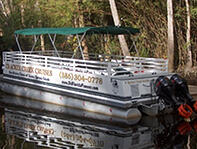 This vessel was purchased “previously owned” (probably late 2006) from a company that used it as a taxi service in Jacksonville. The engines are original and presently have just less than 5000 hours on them. They are Honda 50 HP 4-strokes with three carburetors per engine. The fuel tanks are aluminum with vertical vents similar to these, which are intended to be mounted horizontally with the opening facing down. In the vertical position, what do you think happens when it rains? Does that explain the plastic cover?
This vessel was purchased “previously owned” (probably late 2006) from a company that used it as a taxi service in Jacksonville. The engines are original and presently have just less than 5000 hours on them. They are Honda 50 HP 4-strokes with three carburetors per engine. The fuel tanks are aluminum with vertical vents similar to these, which are intended to be mounted horizontally with the opening facing down. In the vertical position, what do you think happens when it rains? Does that explain the plastic cover?
Regarding the Mix-I-Go gasoline additive (been a user since 1995): I have been using Mixigo gasoline additive in a 1984 31ft. Wellcraft Express Cruiser for many years, up until 2008 when we sold it. The boat is powered by 2-GM big block 454’s and has 2-40 gal. and 2-80 gal. fuel tanks. While this fuel capacity is great for ocean going trips, we never really had to take advantage of that much fuel. So, you can imagine how we were always switching back and forth from tank to tank to minimize the aging process of the gasoline in the tanks. I did use the proper fuel/water separators and when changing them periodically, I always punched a hole in them to see how much water they had trapped. I never found water in the filters and the engines always ran really well considering their age and hours.
This, I attribute to always adding the 2 oz. per 10 gal. ratio of Mixigo whenever adding fuel.
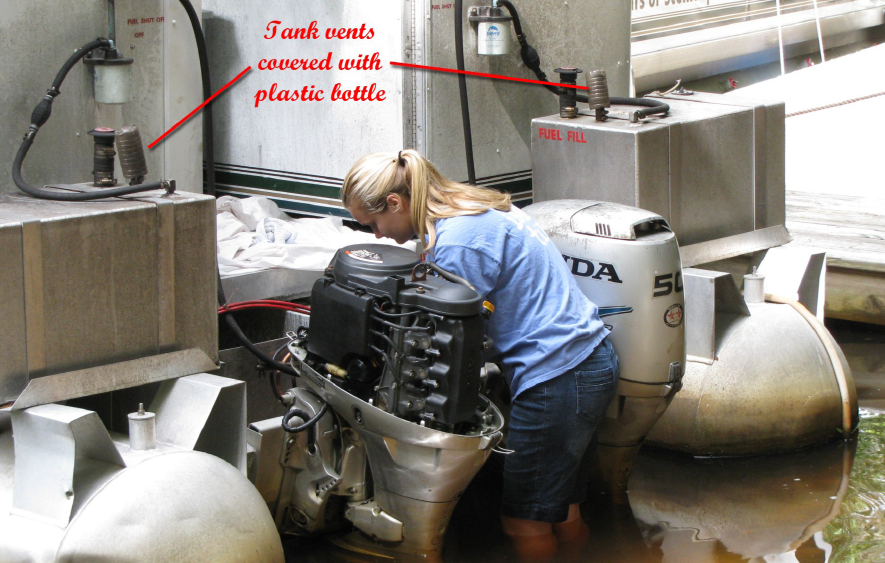
In February, 2007, I began employment at Cracker Creek Canoeing in Port Orange, FL as a tour boat operator (Captain) and general maintenance mechanic. I found that the company owned a 41 ft. pontoon boat powered by 2-Honda 50 HP 4-stroke engines. They were far from new and were in need of some TLC. With my experience with Mixigo, I realized that these engines were the perfect candidates for the Mixigo fuel additive.
Following are the details involved as to why I use Mixigo in this vessel: It is docked in Spruce Creek, approximately 9 miles west of the ICWW in an area best described as a “wetlands”. Every night, the aluminum fuel tanks cool down and breathes in the damp swampy air. Every morning, when the sun comes out, they begin to expel this air minus whatever moisture decides to accumulate within the tanks. Hello MIXIGO…
Because there is no nearby marina for fueling with marine grade gasoline, we have to “gas up” with 5 gal. plastic tanks >using ethanol-laced gasoline from the nearby service station. The ethanol and moisture in the tanks get along very well. Hello MIXIGO…
The Honda engines have three carburetors each that cannot tolerate any moisture. Besides gumming up, the brass jets in an aluminum carburetor have a tendency to seize due to the dissimilar metals in a corrosive atmosphere (moisture in the fuel). To reduce the possibility of a carburetor failure, I say, Hello MIXIGO…
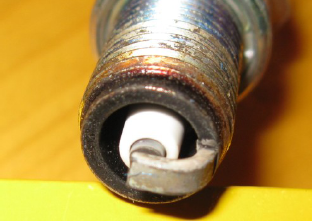 The Honda Owners Manual recommends that the spark plugs be replaced at 200 hours. The photo at right shows the condition of a plug from one of the Hondas at 100 + hours. The center electrode insulator is as clean as when it was new. This has been found to be the same when removed at 200 hours. To me, this indicates the actual condition within the combustion chamber to be carbon free due to the Mixigo detergent action. Also contributing is the combustion modifier in Mixigo that allows a cleaner burn of the fuel. Again, I say Hello MIXIGO!
The Honda Owners Manual recommends that the spark plugs be replaced at 200 hours. The photo at right shows the condition of a plug from one of the Hondas at 100 + hours. The center electrode insulator is as clean as when it was new. This has been found to be the same when removed at 200 hours. To me, this indicates the actual condition within the combustion chamber to be carbon free due to the Mixigo detergent action. Also contributing is the combustion modifier in Mixigo that allows a cleaner burn of the fuel. Again, I say Hello MIXIGO!
Thanks for the great performance of our “Happy Hondas”.From your friend at Cracker Creek, Captain Larry http://www.crackercreek.com/
Thanks, Captain Larry, for telling us the story of your experiences with Mix-I-Go!
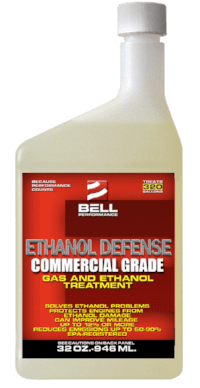
Since its introduction a few years ago, we've talked about the benefits that small engine users can see from treating their ethanol gasoline with ...
There are a number of places on the Bell website that are designed to enable people to ask us technical questions. We got a question this week from...
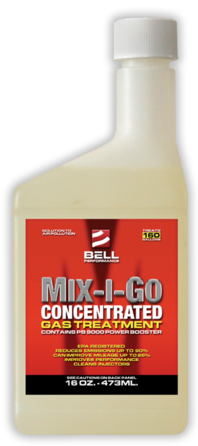
We try to encourage our customers to let us know how they like their purchases, and many times we will hear from customers who started using Bell...